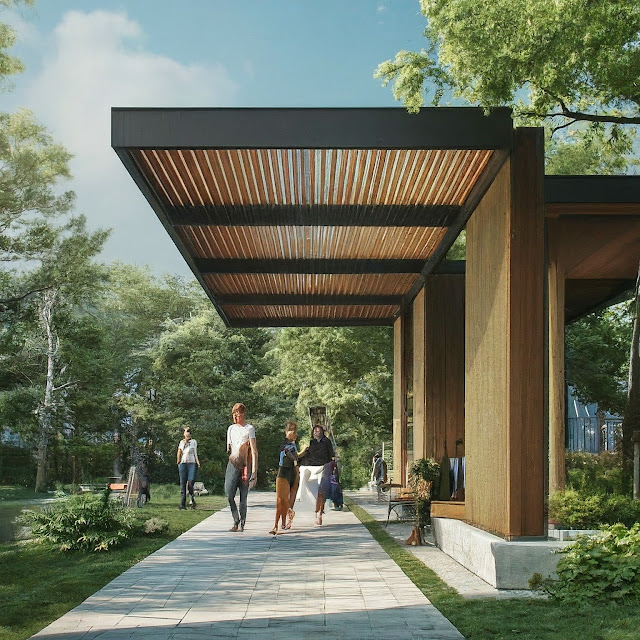-----
Building Green: Strategies for Reducing the Carbon Footprint of Architecture
In an era where environmental sustainability is paramount, the architecture and construction industry faces a pivotal challenge: reducing the carbon footprint of buildings. Buildings are significant contributors to carbon emissions due to their energy consumption, material usage, and operational impact. However, with innovative design strategies and sustainable practices, architects and builders can mitigate this environmental impact and create buildings that are not only aesthetically pleasing but also environmentally responsible. In this article, we delve into the strategies for reducing the carbon footprint of buildings, paving the way for a more sustainable built environment.
Energy Efficiency and Passive Design:
One of the most effective ways to reduce the carbon footprint of a building is through energy efficiency measures and passive design strategies. This includes optimizing the building's orientation to maximize natural daylighting and minimize solar heat gain, utilizing high-performance insulation to minimize thermal bridging, and implementing energy-efficient HVAC systems, lighting, and appliances. By reducing energy demand and reliance on fossil fuels for heating, cooling, and lighting, buildings can significantly decrease their carbon emissions.
Renewable Energy Integration:
Another key strategy for reducing the carbon footprint of buildings is integrating renewable energy sources such as solar photovoltaic (PV) panels, wind turbines, and geothermal systems. By generating clean, renewable energy on-site, buildings can offset their energy consumption and reduce reliance on grid-supplied electricity, which is often generated from fossil fuels. Renewable energy integration not only reduces carbon emissions but also contributes to long-term cost savings and energy independence.
Sustainable Materials and Life Cycle Assessment:
The materials used in building construction also play a significant role in determining the carbon footprint of a building. Sustainable materials such as recycled steel, reclaimed wood, and low-carbon concrete can help reduce embodied carbon emissions associated with construction. Additionally, conducting a life cycle assessment (LCA) of building materials allows architects and builders to evaluate the environmental impact of materials throughout their entire life cycle, from extraction and manufacturing to use and disposal. By prioritizing materials with lower embodied carbon and environmental impact, buildings can significantly reduce their carbon footprint.
Water Conservation and Management:
Water conservation and management are integral components of reducing the carbon footprint of buildings. Implementing water-efficient fixtures, rainwater harvesting systems, and greywater recycling systems can help minimize water consumption and reduce the energy required for water treatment and distribution. Additionally, sustainable landscaping practices such as native plantings and permeable paving can help reduce water usage and mitigate stormwater runoff, further contributing to the overall sustainability of a building.
Green Building Certifications and Standards:
Green building certifications and standards such as LEED (Leadership in Energy and Environmental Design), BREEAM (Building Research Establishment Environmental Assessment Method), and Passive House provide frameworks for designing and constructing environmentally sustainable buildings. These certifications consider various aspects of sustainability, including energy efficiency, water conservation, indoor air quality, and materials selection. By adhering to green building standards and seeking certification, architects and builders can ensure that buildings are designed and constructed to the highest environmental standards, thereby reducing their carbon footprint.
Conclusion:
Reducing the carbon footprint of buildings is a multifaceted challenge that requires a holistic approach encompassing energy efficiency, renewable energy integration, sustainable materials, water conservation, and green building certifications. By incorporating these strategies into architectural design and construction practices, architects and builders can create buildings that not only minimize environmental impact but also contribute to a more sustainable and resilient built environment. As the architecture and construction industry continues to evolve, the adoption of sustainable practices will play a crucial role in mitigating climate change and shaping a more sustainable future for generations to come.
------------
Below are some of my sketches and basic renders.
Each month, I spend a lot of time in order to keep the blog going , design and publish new material and sketches. For 4 years I published sketches for free creating the biggest collection of this kind of architectural sketches on the web. It has remained free and ad-free and alive thanks to support from viewers. I have no staff, I keep alone myself this blog. If this blog have made your own life easier or help your creativity, maybe giving you new ideas, please consider aiding its sustenance with a donation. Your support makes all the difference.
All the sketches and art on this blog and Pinterest are for sale, and can be used after agreement with me.
Thank you,
Bozelos Panagiotis - Civil engineer - Architect
LINKEDIN PROFILE: https://www.linkedin.com/in/panagiotis-bozelos-96b896240
RESUME : https://drive.google.com/file/d/1mKd0tFYFREnN1mbsT0t42uOavFln4UOo/view?usp=sharing
BLOG: www.architectsketch.blogspot.com
PINTEREST (sketches): https://gr.pinterest.com/bozelos/sketches-and-plans/
PINTEREST ART: https://gr.pinterest.com/bozelos/bozelos-panagiotis-art/
Don't hessitate to communicate with me for anything you want.
Contact info:
bozpan13@gmail.com
bozpan@protonmail.com
TEL: 00306945176396
DONATE ME : Donate to Panagiotis Bozelos
Buy art: GalleryBlend - Buy printed Art
---------------------------

_0.jpg)
_1.jpg)
_0.jpg)
_1.jpg)
_0.jpg)
_1.jpg)
_0.jpg)
_1.jpg)
_0.jpg)
_1.jpg)


















No comments:
Post a Comment